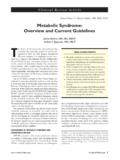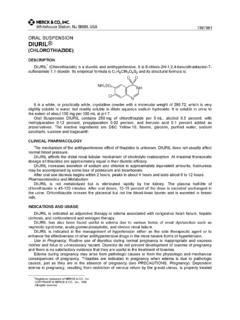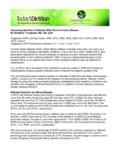Transcription of ZOLAMIDE Brand Name: ZOLAMIDE THERAPEUTIC …
1 ZOLAMIDE Brand Name: ZOLAMIDE Generic Name: acetazolamide THERAPEUTIC CATEGORY: Carbonic Anhydrase Inhibitor; Anticonvulsant Composition: Each tablet contains acetazolamide USP 250 mg Available in 10 Tablets X 10 Blisters THERAPEUTIC CATEGORY: Carbonic Anhydrase Inhibitor; Anticonvulsant Description: acetazolamide is a potent Carbonic Anhydrase inhibitor, effective in the control of fluid secretion ( some types of glaucoma), in the treatment of certain convulsive disorders ( , epilepsy) and in the promotion of diuresis in instances of abnormal fluid retention ( , cardiac edema). acetazolamide , is used to treat glaucoma, epileptic seizures, benign intracranial hypertension (pseudotumor cerebri), altitude sickness, cystinuria and dural ectasia.
2 acetazolamide is also a "water pill" (diuretic) and is used the patients with congestive heart failure. PHARMACOKINETICS Onset of action: 30 minutes Peak action: 1-4 hours Duration of action: 8-12 hours MECHANISM OF ACTION acetazolamide is a non-competitive inhibitor of carbonic anhydrase, an enzyme found in cells in the proximal tube of the kidney; the eyes and glial cells. Carbonic anhydrase (CA) catalyzes the forward motion of molecules in the following equation: CO2 + H2O >> CA >> H2CO3 >> H+ + HCO3- where CA converts carbon dioxide (CO2) and water (H2O) to carbonic acid (H2CO3), but this is only the case when the current concentration of carbonic acid is less than it would be at equilibrium.
3 Enzymes DO NOT catalyze only one direction of a chemical reaction. Nevertheless, in situations where pCO2 is increased, CA does catalyze the formation of carbonic acid which then dissociates to a hydrogen ion (H+, an acidic proton), and a bicarbonate ion (HCO3-, a basic anion). In some tissues (particularly plants), the steady state displacement from equilibrium is such that the net reaction catalyzed by CA is conversion of carbonic acid to carbon dioxide and water. Carbonic acid inhibitors, such as acetazolamide , inhibit CA in tissue and fluid, causing less movement of carbonic acid toward CO2 production. In the eye, this inhibitory action of acetazolamide decreases the secretion of aqueous humor and results in a drop in intraocular pressure, a reaction considered desirable in cases of glaucoma and even in certain nonglaucomatous conditions.
4 Inhibition of this enzyme in the kidney forces the kidneys to excrete bicarbonate. By increasing the amount of bicarbonate excreted in the urine, the blood becomes more acidic. Acidifying the blood stimulates ventilation, which increases the amount of oxygen in the blood. In the kidneys, blocking CA leads to bicarbonate wasting in the tubules (alkalizes urine), loss of bicarbonate subsequently leads to a metabolic acidosis. The diuretic effect of acetazolamide is due to its action in the kidney on the reversible reaction involving hydration of carbon dioxide and dehydration of carbonic acid. The result is renal loss of HCO3 ion, which carries out sodium, water, and potassium.
5 Alkalinization of the urine and promotion of diuresis are thus effected. Alteration in ammonia metabolism occurs due to increased reabsorption of ammonia by the renal tubules as a result of urinary alkalinization. Evidence seems to indicate that acetazolamide has utility as an adjuvant in the treatment of certain dysfunctions of the central nervous system ( , epilepsy). Inhibition of carbonic anhydrase in this area appears to retard abnormal, paroxysmal, excessive discharge from central nervous system neurons. In the meantime, H+ backs up due to acetazolamide CA inhibition in the tubule and enters the cell with Cl-, then passes into the bloodstream, creating a hyperchloremic metabolic acidosis.
6 This effect can also be used for THERAPEUTIC correction of respiratory alkalosis. Uses: acetazolamide is often used in the treatment of various diseases which includes: 1. Acute mountain sickness acetazolamide is sometimes taken prophylactically, anywhere between 125 milligrams (mg) to 500 mg per day, starting a few days before going to the higher altitude. Such use is recommended for those ascending from sea level to 3000 meters (9800 feet) in one day, or for those ascending more than 600 meters (2000 feet) per day once above an altitude of 2500 meters (8200 feet). Also, prophylactic use is recommended for those with a significant history of acute mountain sickness.
7 2. Glaucoma It has been used for adjunctive treatment of chronic simple (open-angle) glaucoma, secondary glaucoma, and preoperatively in acute angle-closure glaucoma where delay of surgery is desired in order to lower intraocular pressure. The drug reduces the concentration of bicarbonate, resulting in a decreased synthesis of aqueous humor, thereby lowering intraocular pressure. 3. Neurologic Disorders In epilepsy, its main use is in absence seizures and myoclonic seizures. It can be used in both episodic ataxia types 1 and 2 (although the mechanisms are presumed to be different between the two). In catamential epilepsy, an increase in seizure frequency around menses, acetazolamide can be an adjunct to an anti-seizure medication regimen to aid in decreasing seizure frequency around menses.
8 It is also used to decrease generation of cerebrospinal fluid in idiopathic intracranial hypertension and has shown efficacy in some forms of periodic paralysis. 4. Sleep apnea: Sleep apnea (or sleep apnoea in British English) is a sleep disorder characterized by pauses in breathing during sleep. Each episode, called an apnea lasts long enough so that one or more breaths are missed, and such episodes occur repeatedly throughout sleep. Medications like acetazolamide lower blood pH and encourage respiration. Low doses of oxygen are also used as a treatment for hypoxia but are discouraged due to side effects.
9 Off-label uses include acetazolamide as a conjunction drug to merely assist patients with sleep apnea by lowering blood pH and encourage respiration. 5. Marfan syndrome Marfan syndrome (also called Marfan's syndrome) is a genetic disorder of the connective tissue. acetazolamide has been demonstrated in drug trials to relieve symptoms associated with dural ectasia (the weakening of the connective tissue of the dural sac, the membrane that encases the spinal cord) in individuals with Marfan Syndrome. DOSAGE AND ADMINISTRATION 1. Acute Mountain Sickness: For prevention, 125 to 250mg twice daily starting one or two days before and continuing for three days once the highest altitude is reached, is effective.
10 Blood concentrations of acetazolamide peak between one to four hours after administration of the tablets. The recommended dose is 250mg (one tablet) twice a day when required. It is preferable to initiate dosing 24 to 48 hours before ascent and continue with the treatment while ascending, until one is fully acclimatised to their final altitude. On most treks, gradual ascent is possible and prophylaxis tends to be discouraged. Certainly if trekkers do develop headache and nausea or the other symptoms of AMS, then treatment with acetazolamide is fine. The treatment dosage is 250 mg twice a day for about three days. (Note that acetazolamide is not an immediate fix for acute mountain sickness; it speeds up part of the acclimatisation process which in turn helps to relieve symptoms.)







